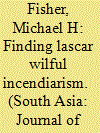|
|
|
Sort Order |
|
|
|
Items / Page
|
|
|
|
|
|
|
| Srl | Item |
| 1 |
ID:
114658


|
|
|
|
|
| Publication |
2012.
|
| Summary/Abstract |
From the 1790s to the 1850s, three dozen major merchant ships burned in India's important ports. Panic-stricken British shipowners, merchants and East India Company officials apprehended disruption of their intercontinental trade, so vital to the burgeoning British Empire. In all these cases, they accused Indian seamen (lascars) of selfish ship-burning. As a context, the lascars had, for centuries prior to European arrival in the Indian Ocean, worked collectively under their own petty officers. They and Indian recruiters in each port had long resisted colonial efforts to appropriate their maritime labour system. Britons used this half-century of alleged arson to finally impose British controls over lascar recruitment ashore and conditions of service aboard ships.
|
|
|
|
|
|
|
|
|
|
|
|
|
|
|
|
| 2 |
ID:
169930


|
|
|
|
|
| Summary/Abstract |
Between the 18th and 26th of November 2016, 220 different locations went up in flames in the Israeli forest. Israeli firefighters were powerless to contain the fires, so army and police units had to contribute. Thousands of civilian volunteers also joined the fight against the fire. The Israeli firemen were unable to curb the continuously blazing fires, which is why the Prime Minister, Benjamin Netanyahu, asked and received international support. The operation lasted for eight days, more than 1,700 fires were eliminated, but the conflagration caused considerable damage. Due to the extremely dry and windy periods, many blamed the weather conditions for the damage, but it soon became clear that in several cases, the cause was arson. Although arson as a method of extremism has been continuously practiced in many incidents worldwide, it is still beyond the scope of research on terrorism. This essay aims to prove that we have to raise awareness of the issue, highlighting both relevant incidents and the extremist group’s propaganda incentive towards the enhanced use of arson. We raise the question whether on the basis of the incidents in Israel, arson could become a frequently used method of European terrorist units or individuals. And if yes, how the national counter-terrorist and law-enforcement agencies may adapt to the challenge of hardly controllable arson in order to minimize the chance of similarly executed attacks in the future.
|
|
|
|
|
|
|
|
|
|
|
|
|
|
|
|
| 3 |
ID:
134350


|
|
|
|
|
| Summary/Abstract |
Nearly every week there are stories of destructive fires in Kenyan secondary schools. Most of these are suspected arson cases, and the usual suspects are the schools' current students. This article provides the first analysis of the recent spate of school-based fire incidents, based on a comprehensive survey of media, government, and court reports, as well as primary data collected through interviews with students, educators, and administrators. This evidence clearly demonstrates that school-based arson is a phenomenon that spans regions in Kenya, and occurs in boys', girls', and mixed schools, private and public schools, and across school calendars. Current and former students explain this trend in terms of arson's effectiveness as a tactic in protest politics. Based on these findings, I argue that school-based arson is indicative of more than the contested conditions of education in Kenya today. The use of arson by students reflects what this generation has learned about how protest and politics work in Kenya. Students' recognition that destructive collective actions are efficacious in winning a response from authorities highlights that learning and feeds a reactionary mode of governance in which citizens' initiatives tend to be neglected until they pose direct threats to public peace and financing.
|
|
|
|
|
|
|
|
|
|
|
|
|
|
|
|
|
|
|
|
|